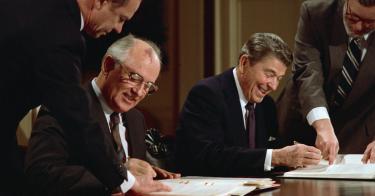As Ronald Reagan assumed the presidency, he was greatly troubled by what he saw around the world. For more than three decades, the U.S. and its allies had striven to contain communism through a series of diplomatic, economic and military initiatives that had cost hundreds of billions of dollars and tens of thousands of lives. Yet communism still gripped the Soviet Union, Eastern and Central Europe, China, Cuba, Vietnam and North Korea, and had spread to sub-Saharan Africa, Afghanistan and Nicaragua.
Whatever its early success, the policy of containment clearly no longer worked. Reagan determined that the time had come for a new strategy: “We win and they lose.”
In his first presidential press conference, Reagan stunned official Washington by denouncing the Soviet leadership as still dedicated to “world revolution and a one-world Socialist-Communist state.” As he wrote in his official autobiography, “I decided we had to send as powerful a message as we could to the Russians that we weren’t going to stand by anymore while they armed and financed terrorists and subverted democratic governments.”
Based on intelligence reports and his life-long study, Reagan concluded that Soviet communism was cracking and ready to crumble. In May 1982 he went public with his assessment of the Soviets’ systemic weakness. Speaking at his alma mater, Eureka College, he declared that the Soviet empire was “faltering because rigid centralized control has destroyed incentives for innovation, efficiency, and individual achievement.”
One month later, in a prophetic address to the British Parliament at Westminster, Reagan said that the Soviet Union was gripped by a “great revolutionary crisis” and that a “global campaign for freedom” would ultimately prevail. He boldly predicted that “the march of freedom and democracy … will leave Marxism-Leninism on the ash-heap of history as it has left other tyrannies which stifle the freedom and muzzle the self-expression of the people.”
He directed his top national security team to develop a plan to end the Cold War by winning it. The result was a series of top-secret national security decision directives that:
- Committed the U.S. to “neutralizing” Soviet control over Eastern Europe and authorized covert action and other means to support anti-Soviet groups in the region.
- Adopted a policy of attacking a “strategic triad” of critical resources –financial credits, high technology and natural gas – essential to Soviet economic survival. Author-economist Roger Robinson said the directive was tantamount to “a secret declaration of economic war on the Soviet Union.”
- Determined that, rather than coexist with the Soviet system, the U.S. would seek to change it fundamentally. The language, drafted by Harvard historian Richard Pipes, was unequivocal: America intended to “roll back” Soviet influence at every opportunity.
Following these directives, the administration pursued a multifaceted foreign policy offensive that included covert support of the Solidarity movement in Poland, an increase in pro-freedom public diplomacy (through instruments like the National Endowment for Democracy), a global campaign to reduce Soviet access to Western high technology and a drive to hurt the Soviet economy by driving down the price of oil and limiting natural gas exports to the West.
A key element of Reagan’s victory strategy was the support of anti-communist forces in Afghanistan, Nicaragua, Angola and Cambodia. The “Reagan Doctrine” (a name coined by syndicated columnist Charles Krauthammer) was the most cost-effective of all the cold war doctrines, costing the United States less than a billion dollars a year while forcing the cash-strapped Soviets to spend some $8 billion annually to deflect its impact. It was also one of the most politically successful doctrines in Cold War history, resulting in a Soviet pullout from Afghanistan, the election of a democratic government in Nicaragua and the removal of 40,000 Cuban troops from Angola and the holding of United Nations-monitored elections there.
And then there was SDI—the Strategic Defense Initiative. Dismissed as “Star Wars” by U.S. skeptics, it put the Soviet military in a state of fear and shock. A decade later, a top Soviet strategist revealed what he had told the Politburo at the time: “Not only could we not defeat SDI, SDI defeated all our possible countermeasures.”
The American president who effectively wrote finis to the Cold War was Ronald Reagan. He entered the Oval Office with a clear set of ideas he had developed over a lifetime of study. He forced the Soviet Union to abandon its goal of world communism by challenging its legitimacy, regaining superiority in the arms race and using human rights as a powerful psychological weapon.
By the time Reagan left office in January 1989, the Reagan Doctrine had achieved its goal: Mikhail Gorbachev, the last leader of the Soviet system, publicly acknowledged the failures of Marxism-Leninism and the futility of Russian imperialism. In Margaret Thatcher’s words, Ronald Reagan had ended the Cold War without firing a shot.
This piece originally appeared in The Hill on 12/26/19



